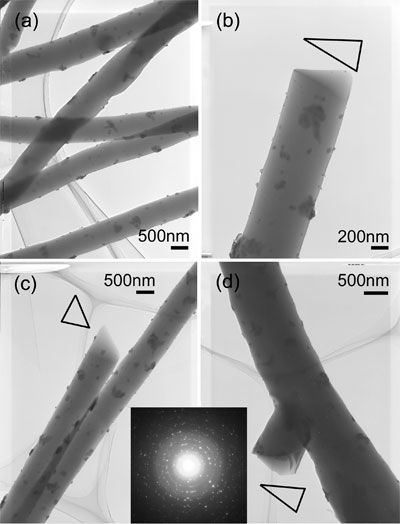| Posted: Aug 02, 2006 | |
Triangular cross-sectional silica fibers: a novel growth phenomenon for amorphous materials |
|
| (Nanowerk Spotlight) Researchers in Japan have synthesized novel silica fibers. Unlike any previously reported one-dimensional silica nano- and microstructures, the novel fibers display a triangular cross-section, which is not typical for amorphous materials. These prism-like silica fibers open up a new morphological type of silicon-based materials which may have highly promising potentials. They may be of significant interest for optoelectronic applications and the improvement of SnO2 chemical sensors and catalysts. | |
| In a recent article, titled "Silica Fibers with Triangular Cross-Sections" first author Dr. Junqing Hu, Independent Research Fellow at the International Center for Young Scientists (ICYS) in Japan, together with Prof. Yoshio Bando and Prof. Dmitri Golberg, both from the National Institute for Materials Science (NIMS), have reported on the large-scale synthesis of triangular cross-sectional silica fibers. | |
| "Faceted" solids are common in inorganic crystal materials, owing to the favorable growth of specific planes of a low surface energy. By contrast, such faceted morphologies are rather rare in inorganic amorphous materials and their fabrication is still a challenge. | |
| Dr. Hu explains his team's findings to Nanowerk: "We synthesized amorphous silica fibers with a high yield via a so-called Sn-catalyzed vapor-liquid-solid (VLS) process through thermal co-decomposition of SiO and SnO powders. The resulting silica fibers are surface-decorated with SnO2 nanoparticles, forming SiO2/SnO2 fiber/particle heterostructures." | |
 |
|
| Figure (a) Transmission electron microscope (TEM) image of uniform SnO2 surface-decorated silica fibers. (b) TEM image clearly demonstrates the triangular cross section of a silica fiber. (c) and (d) TEM images show that the "Y" or "T" structure branches display the triangular cross sections respectively. The inset (bottom-middle) shows the corresponding electron diffraction pattern. (Reprinted with permission from Wiley) | |
| The Sn-catalyzed VLS growth route towards the fabrication of hierarchical heterostructures composed of Si core microwires and SiO2 nanowire covering shells is a new process recently developed by the same researchers at NIMS. | |
| "In this work" explains Hu, "we extend this route to a two-stage well-controllable process for the synthesis of triangular cross-section silica fibers. The synthesis was accomplished through the thermal co-decomposition of SiO and SnO powders in a simple horizontal high-temperature resistance furnace." | |
| "Our SnO2 surface-decorated silica fibers (or SiO2/SnO2 fiber/particle heterostructures) could potentially serve as SnO2 co-doped SiO2 optical fibers" says Hu. "They have been demonstrated to have high enough photosensitivity and could be most compatible with standard telecom fibers." | |
 By
Michael
Berger
– Michael is author of three books by the Royal Society of Chemistry:
Nano-Society: Pushing the Boundaries of Technology,
Nanotechnology: The Future is Tiny, and
Nanoengineering: The Skills and Tools Making Technology Invisible
Copyright ©
Nanowerk LLC
By
Michael
Berger
– Michael is author of three books by the Royal Society of Chemistry:
Nano-Society: Pushing the Boundaries of Technology,
Nanotechnology: The Future is Tiny, and
Nanoengineering: The Skills and Tools Making Technology Invisible
Copyright ©
Nanowerk LLC
|
Become a Spotlight guest author! Join our large and growing group of guest contributors. Have you just published a scientific paper or have other exciting developments to share with the nanotechnology community? Here is how to publish on nanowerk.com.
